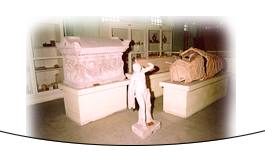Kastamonu - Archeological Museum - Atatürk Hall
The museum building that was drawn by the Architect Kemalettin Bey, was first used on 1910 as the Union and Progress Society building, and later on, on 1921 it was given to the service of the Independence Tribunal.
Until 1940’s which the building was used by various institutions and society’s such as Turkish Nationalist Club, People’s Party, Kastamonu Youth Organization, on 1945 it was taken over by the Office of the National Education and transformed into a museum.
On 1952 the building was designated as the museum directorate. Various glasses, fired clays, statues, tombs and tomb covers are exhibited in the museum from the Hellenistic, Roman and Byzantium periods that are found in Kastamonu and its regions. Also, a part of the display was arranged as the Atatürk Room, where various goods used by Atatürk during his visit to Kastamonu in 1925 and photographs are exhibited.
A tomb - At the front side of the Roman tomb two wreaths, in the middle a head of a bull and at the top the warrior Dioscur can be seen. At the rear side two wreaths, a medusa head, above the wreath a lion and eagle relief can be seen.
 A satyr - A marble statue of a nude male from the Roman period. It stands on a base and holds a pouch that is placed between his shoulders.
A satyr - A marble statue of a nude male from the Roman period. It stands on a base and holds a pouch that is placed between his shoulders.
A small statue of a woman - The small fired clay statue is from the Hellenistic period. She is sitting on a throne and with her right hand holding her hair. A lion under her right arm and a crown on her head can be seen. The curls on her dress look extremely natural.
A tomb - It is from Roman period and made of hard white marble. It is in very good condition. The box and the lid hold each other with a metal clamp. The lid looks like a high pointed roof and there are acroteriums in the corners. A half wreath, a flower above the wreath, again, a half wreath at right and above it a head (can be Eros) and inscriptions in the middle can be seen on the tomb.
An obelisk - (A gravestone) It was pierced in the middle and made of pale limestone. There is an inscription on the top front part of the obelisk, and below the inscription there are certain objects and tools such as a knife, a comb, a basket, a legged pot can be seen. And on the below part of the obelisk a vase, grapevine and grapes, an adze, a hook appears. And at the bottom some cutting tools can be seen.